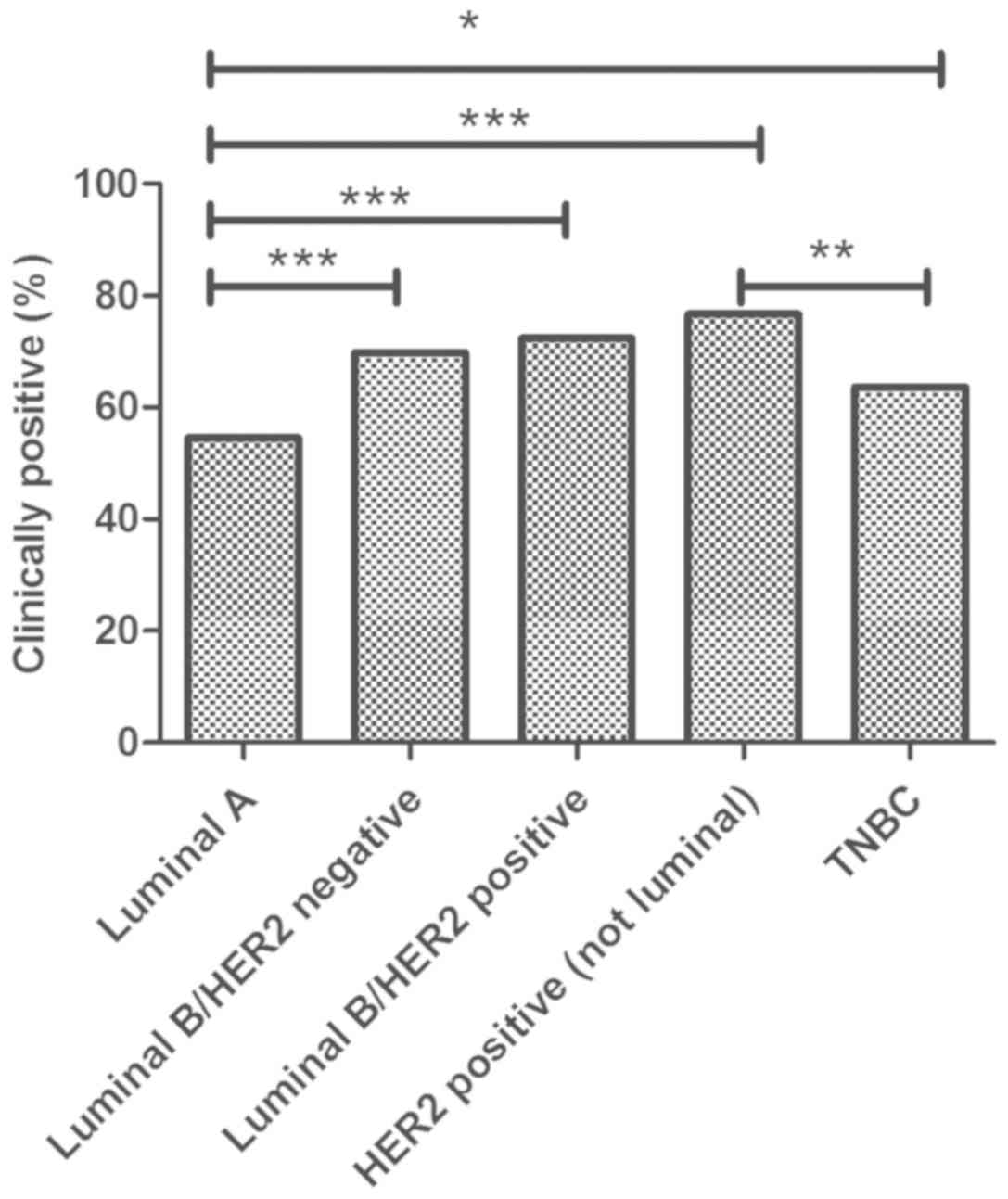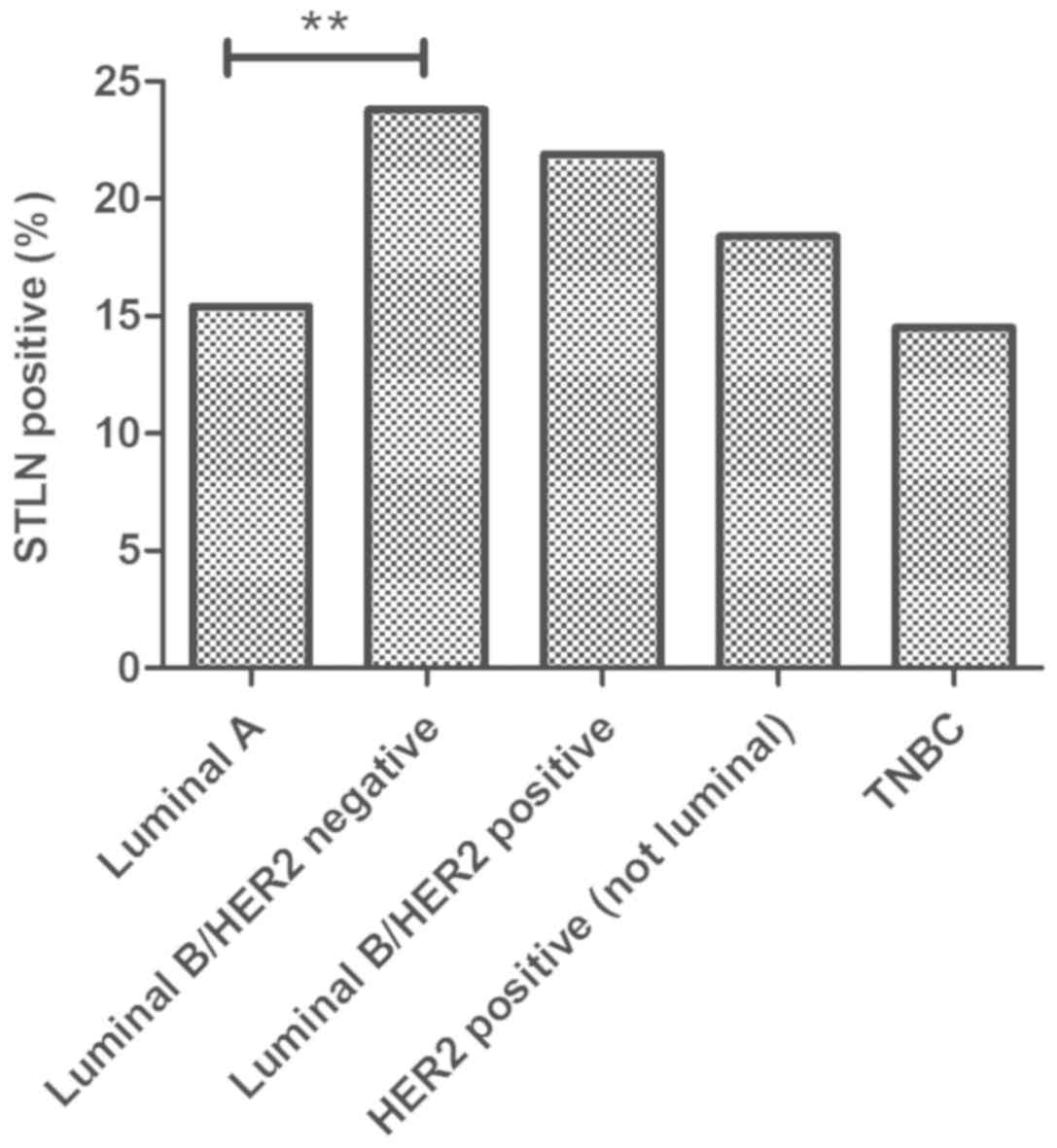|
1
|
Moo TA, Sanford R, Dang C and Morrow M:
Overview of breast cancer therapy. PET Clin. 13:339–354. 2018.
View Article : Google Scholar : PubMed/NCBI
|
|
2
|
Sørlie T, Perou CM, Tibshirani R, Aas T,
Geisler S, Johnsen H, Hastie T, Eisen MB, van de Rijn M, Jeffrey
SS, et al: Gene expression patterns of breast carcinomas
distinguish tumor subclasses with clinical implications. Proc Natl
Acad Sci USA. 98:10869–10874. 2001. View Article : Google Scholar : PubMed/NCBI
|
|
3
|
Goldhirsch A, Winer EP, Coates AS, Gelber
RD, Piccart-Gebhart M, Thürlimann B and Senn HJ; Panel members, :
Personalizing the treatment of women with early breast cancer:
Highlights of the St Gallen International expert consensus on the
primary therapy of early breast cancer 2013. Ann Oncol.
24:2206–2223. 2013. View Article : Google Scholar : PubMed/NCBI
|
|
4
|
Vasconcelos I, Hussainzada A, Berger S,
Fietze E, Linke J, Siedentopf F and Schoenegg W: The St. Gallen
surrogate classification for breast cancer subtypes successfully
predicts tumor presenting features, nodal involvement, recurrence
patterns and disease free survival. Breast. 29:181–185. 2016.
View Article : Google Scholar : PubMed/NCBI
|
|
5
|
Jatoi I, Benson JR and Toi M:
De-escalation of axillary surgery in early breast cancer. Lancet
Oncol. 17:e430–e441. 2016. View Article : Google Scholar : PubMed/NCBI
|
|
6
|
Veronesi U, Viale G, Paganelli G, Zurrida
S, Luini A, Galimberti V, Veronesi P, Intra M, Maisonneuve P, Zucca
F, et al: Sentinel lymph node biopsy in breast cancer: Ten-year
results of a randomized controlled study. Ann Surg. 251:595–600.
2010. View Article : Google Scholar : PubMed/NCBI
|
|
7
|
Lyman GH, Somerfield MR and Giuliano AE:
Sentinel lymph node biopsy for patients with early-stage breast
cancer: 2016 American Society of clinical oncology clinical
practice guideline update summary. J Oncol Pract. 13:196–198. 2017.
View Article : Google Scholar : PubMed/NCBI
|
|
8
|
Yan M, Abdi MA and Falkson C: Axillary
management in breast cancer patients: A comprehensive review of the
key trials. Clin Breast Cancer. 18:e1251–e1259. 2018. View Article : Google Scholar : PubMed/NCBI
|
|
9
|
Gentilini O and Veronesi U: Abandoning
sentinel lymph node biopsy in early breast cancer? A new trial in
progress at the European Institute of Oncology of Milan (SOUND:
Sentinel node vs. observation after axillary UltraSouND). Breast.
21:678–681. 2012. View Article : Google Scholar : PubMed/NCBI
|
|
10
|
Veronesi U, Paganelli G, Viale G, Luini A,
Zurrida S, Galimberti V, Intra M, Veronesi P, Maisonneuve P, Gatti
G, et al: Sentinel-lymph-node biopsy as a staging procedure in
breast cancer: Update of a randomised controlled study. Lancet
Oncol. 7:983–990. 2006. View Article : Google Scholar : PubMed/NCBI
|
|
11
|
Paradiso A, Miller K, Marubini E,
Pizzamiglio S and Verderio P: The need for a quality control of the
whole process of immunohistochemistry human epidermalgrowth factor
receptor 2/neu determination: A United Kingdom National External
Quality Assessment Service/Italian Network for quality assessment
of tumor biomarkers pilot experience. J Clin Oncol. 25:e27–e28.
2007. View Article : Google Scholar : PubMed/NCBI
|
|
12
|
Paradiso A, Volpe S, Iacobacci A, Marubini
E, Verderio P, Costa A, Daidone MG, Marchetti A, Mottolese M,
Amadori D, et al Italian network for quality assessment of tumor
biomarkers, : Quality control for biomarker determination in
oncology: The experience of the Italian network for quality
assessment of tumor biomarkers (INQAT). Int J Biol Markers.
17:201–214. 2002. View Article : Google Scholar : PubMed/NCBI
|
|
13
|
Paradiso A, Scarpi E, Malfettone A, Addati
T, Giotta F, Simone G, Amadori D and Mangia A: Nuclear NHERF1
expression as a prognostic marker in breast cancer. Cell Death Dis.
4:e9042013. View Article : Google Scholar : PubMed/NCBI
|
|
14
|
Lambein K, Van Bockstal M, Denys H and
Libbrecht L: 2013 update of the American society of clinical
oncology/college of American pathologists guideline for human
epidermal growth factor receptor 2 testing: Impact on
immunohistochemistry-negative breast cancers. J Clin Oncol.
32:1856–1857. 2014. View Article : Google Scholar : PubMed/NCBI
|
|
15
|
Hammond MH, Hayes DF, Dowsett M, Allred
DC, Hagerty KL, Badve S, Fitzgibbons PL, Francis G, Goldstein NS,
Hayes M, et al: American society of clinical oncology/college of
American pathologists guideline recommendations for
immunohistochemical testing of estrogen and progesterone receptors
in breast cancer. J Clin Oncol. 28:2784–2795. 2010. View Article : Google Scholar : PubMed/NCBI
|
|
16
|
Medri L, Volpi A, Nanni O, Vecci AM,
Mangia A, Schittulli F, Padovani F, Giunchi DC, Zito A, Amadori D,
et al: Prognostic relevance of mitotic activity in patients with
node-negative breast cancer. Mod Pathol. 16:1067–1075. 2003.
View Article : Google Scholar : PubMed/NCBI
|
|
17
|
Stacker SA, Williams SP, Karnezis T,
Shayan R, Fox SB and Achen MG: Lymphangiogenesis and lymphatic
vessel remodelling in cancer. Nat Rev Cancer. 14:159–172. 2014.
View Article : Google Scholar : PubMed/NCBI
|
|
18
|
Farnsworth RH, Achen MG and Stacker SA:
The evolving role of lymphatics in cancer metastasis. Curr Opin
Immunol. 53:64–73. 2018. View Article : Google Scholar : PubMed/NCBI
|
|
19
|
Argentiero A, De Summa S, Di Fonte R,
Iacobazzi RM, Porcelli L, Da Vià M, Brunetti O, Azzariti A,
Silvestris N and Solimando AG: Gene expression comparison between
the lymph node-positive and -negative reveals a peculiar immune
microenvironment signature and a theranostic role for WNT targeting
in pancreatic ductal adenocarcinoma: A pilot study. Cancers
(Basel). 11:9422019. View Article : Google Scholar
|
|
20
|
Tjan-Heijnen V and Viale G: The lymph node
and the metastasis. N Engl J Med. 378:2045–2046. 2018. View Article : Google Scholar : PubMed/NCBI
|
|
21
|
Galimberti V, Cole BF, Zurrida S, Viale G,
Luini A, Veronesi P, Baratella P, Chifu C, Sargenti M, Intra M, et
al: IBCSG 23-01 randomised controlled trial comparing axillary
dissection versus no axillary dissection in patients with
sentinel-node micrometastases. Lancet Oncol. 14:297–305. 2013.
View Article : Google Scholar : PubMed/NCBI
|
|
22
|
Sato K, Tamaki K, Shigekawa T, Tsuda H,
Kosuda S, Kusano S, Hiraide H and Mochizuki H: Clinicopathologic
and technical factors associated with the uptake of radiocolloid by
sentinel nodes in patients with breast cancer. Surg Today.
33:403–407. 2003. View Article : Google Scholar : PubMed/NCBI
|
|
23
|
Schwartz ASK, Leo C, Rufibach K, Varga Z,
Fink D and Gabriel N: Does increased tumor burden of sentinel nodes
in breast cancer affect detection procedure? Eur J Surg Oncol.
39:266–272. 2013. View Article : Google Scholar : PubMed/NCBI
|
|
24
|
Ding J, Jiang L and Wu W: Predictive Value
of clinicopathological characteristics for sentinel lymph Node
Metastasis in early breast cancer. Med Sci Monit. 23:4102–4108.
2017. View Article : Google Scholar : PubMed/NCBI
|
|
25
|
Thangarajah F, Malter W, Hamacher S,
Schmidt M, Krämer S, Mallmann P and Kirn V: Predictors of sentinel
lymph node metastases in breast cancer-radioactivity and Ki-67.
Breast. 30:87–91. 2016. View Article : Google Scholar : PubMed/NCBI
|
|
26
|
Ozemir IA, Orhun K, Eren T, Baysal H,
Sagiroglu J, Leblebici M, Ceyran AB and Alimoglu O: Factors
affecting sentinel lymph node metastasis in Turkish breast cancer
patients: Predictive value of Ki-67 and the size of lymph node.
Bratisl Lek Listy. 117:436–441. 2016.PubMed/NCBI
|
|
27
|
Malter W, Hellmich M, Badian M, Kirn V,
Mallmann P and Krämer S: Factors predictive of sentinel lymph node
involvement in primary breast cancer. Anticancer Res. 38:3657–3662.
2018. View Article : Google Scholar : PubMed/NCBI
|
|
28
|
He ZY, Wu SG, Yang Q, Sun JY, Li FY, Lin Q
and Lin HX: Breast cancer subtype is associated with axillary lymph
node metastasis: A retrospective cohort study. Medicine
(Baltimore). 94:e22132015. View Article : Google Scholar : PubMed/NCBI
|
|
29
|
Mao F, Yao R, Peng L, Zhao JL, Liang ZY
and Sun Q: Predictive clinicopathological characteristics affecting
sentinel lymph node metastasis in early breast cancer patients.
Transl Cancer Res. 6:968–975. 2017. View Article : Google Scholar
|
|
30
|
Yanagawa M, Ikemot K, Kawauchi S, Furuya
T, Yamamoto S, Oka M, Oga A, Nagashima Y and Sasaki K: Luminal A
and luminal B (HER2 negative) subtypes of breast cancer consist of
a mixture of tumors with different genotype. BMC Res Notes.
5:3762012. View Article : Google Scholar : PubMed/NCBI
|
|
31
|
Simone G, Diotaiuti S, Digennaro M,
Sambiasi D, De Summa S, Tommasi S, Altieri R, Mangia A, Dantona C
and Paradiso A: Comment on ‘Renewed interest in the progesterone
receptor in breast cancer’. Br J Cancer. 117:e12017. View Article : Google Scholar : PubMed/NCBI
|

















